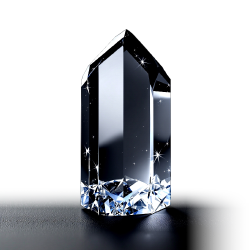Geology
Mohs Hardness Scale
The hardness of a stone is one of the properties that contribute to identification. Hardness is also an attribute which is important to be aware of, because it may determine what a stone may be used for (jewelry, carving, faceting, handling, storage, etc.) You may want to familiarize yourself with the Mohs Scale of Hardness. This will help you understand the relationships between stones according to their hardness.
The Mohs Scale of Hardness consists of 10 classifications, 1 being the softest, and 10 being the hardest. The only mineral that is an exception to this is mercury, which is liquid. To give you a few reference points, the diamond is of course the hardest, rated 10. Your fingernail is a 2, a pocket knife is about a 5-6, and a piece of glass is a 6-7. Each classification will scratch the one preceding it. As you know, a diamond (10) will scratch glass (6-7). This technique is commonly used in the field for initial identification, and it is good to have samples of some of these stones with you in order to perform the test. Some minerals have varying hardness according to the direction you may scratch them in, but typically this is either hardly detectable or an exception to the rule.
The following is a partial listing of stones and their hardness classification:
| 1 | Talc Graphite | Can be scratched with a fingernail and by any stone rated 2+. |
| 2 | Gypsum Bismuth Lepidolite Chlorite | Can be scratched with a fingernail and any stone rated 3+. |
| 3 | Calcite Celestite Barite | Can be scratched with a knife and any stone rated 4+. |
| 4 | Fluorite Malachite Platinum | Can be scratched with a knife and any stone rated 5+. Will scratch any stone rated 3-. |
| 5 | Apatite Dioptase | Can be scratched with a knife and any stone rated 6+. Will scratch any stone rated 4-. |
| 6 | Feldspar Pyrite Amazonite Hematite | Can be scratched with a knife and any stone rated 7+. Will scratch any stone rated 5-. |
| 7 | Quartz Tourmaline | Will scratch glass and any stone rated 6-. Can be scratched by stones 8+. |
| 8 | Topaz Spinel | Will scratch glass and any stone rated 7-. Can be scratched by stones 9-10. |
| 9 | Corundum (ruby, sapphire) | Will scratch glass and any stone rated 8-. Can be scratched by diamond. |
| 10 | Diamond | Will scratch glass and all stones 1-9. |
Rock Classification
| IGNEOUS | Rocks that have solidified from a molten state. There are two types of Igneous rocks: Plutonic - Rock from magma rising up from deep under the earth’s crust, and solidifies as it cools before it reaches the earth’s surface. Volcanic - Rock that was originally lava, hot magma that reached the surface of the earth before it hardened. | Examples of Igneous rock: Plutonic igneous rocks - Granite, Peridotite Volcanic igneous rocks - Obsidian, Basalt, Rhyolite |
| SEDIMENTARY | Rock formed by the accumulation of particles on or near the earth’s surface, and compacted down, often under extreme pressure, creating rock layers. | Examples of sedimentary rock: Limestone, Shale, Sandstone, Dolomite, Gypsum, Quartzite, and stones containing fossils. |
| METAMORPHIC | Rocks resulting from changes within preexisting rocks, by extreme pressure, temperature, and chemical activity. | Examples of metamorphic rock: Kyanite, Mica, Garnet, Calcite, Quartz, Pyrite, Marble, Gneiss, Schist. |
Geologic Timeline of Earth
Paleozoic Era
| CAMBRIAN | 600-500 million years ago | Algae, and invertebrae similar to jellyfish and worms. The firstshelled animals begin to appear in the Cambrian period. Arthopods, Brachiopods, Trilobytes |
| ORDOVICIAN | 500-440 million years ago | Graptolites, Orthoceras, and primitive fish - the first verterbrates begin to appear. |
| SILURIAN | 440-395 million years ago | The first true plants appear. Crinoids are abundant, and eurypterids- believed to be the first air-breathing animal appears. |
| DEVONIAN | 395-345 million years ago | Fish evolve into more complex animals, sharks and amphibians multiply. |
| CARBONIFEROUS | 345-280 million years ago | Ferns are plentiful and the first reptiles evolve from the amphibians.Spiders, cockroaches, scorpions appear. First animals to live on dry land. |
| PERMIAN | 280-225 million years ago | Reptiles become abundant. Trees similar to the pine develop, trilobytes become extinct. |
Mesozoic Era
| TRIASSIC | 225-190 million years ago | The beginning of the dinosaurs. Plant eaters, meat eaters, flying reptiles,and crocodiles. |
| JURASSIC | 190-136 million years ago | The giant dinosaurs developed, as well as abundant plant life and shellfish.Ammonites, lobster, shrimp. |
| CRETACEOUS | 136-65 million years ago | Peak of development, as well as the downfall of the great dinosaurs.Triceratops, Tyrannosaurus Rex, the giant Pterodactyl. Deciduous trees. |
Cenozoic Era
| TERTIARY | 65-2 million years ago | Mammals develop such as camels, bears, cats, monkeys, rodents, dogs.Grasses, fruit develop like what we have today. |
| QUATERNARY | 2 million years ago to present | More mammals develop, including the now extinct Saber-Toothed Tiger and the Mastadon. Modern man appears. |
